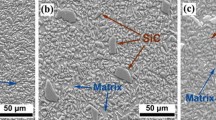Abstract
Micron- and nanometer-sized aluminum particles were used as reinforcements to enhance the fracture toughness of a highly-crosslinked, nominally brittle, thermosetting unsaturated polyester resin. Both particle size and particle volume fraction were systematically varied to investigate their effects on the fracture behavior and the fracture toughness. It was observed that, in general, the overall fracture toughness increased monotonically with the volume fraction of aluminum particles, for a given particle size, provided particle dispersion and deagglomeration was maintained. The fracture toughness of the composite was also strongly influenced by the size of the reinforcement particles. Smaller particles led to a greater increase in fracture toughness for a given particle volume fraction. Scanning electron microscopy of the fracture surfaces was employed to establish crack front trapping as the primary extrinsic toughening mechanism. Finally, the effects of particle volume fraction and size on the tensile properties of the polyester-aluminum composite were also investigated. The measured elastic modulus was in accordance with the rule-of-mixtures. Meanwhile, the tensile strength was slightly reduced upon the inclusion of aluminum particles in the polyester matrix.
Similar content being viewed by others
References
J. N. SULTAN and F. J. MCGARRY, Polymer Engineering and Science 13 (1973) 29.
T. T. WANG and H. M. J. ZUPKO, J. Appl. Polym. Sci. 26 (1981) 2391.
A. J. KINLOCH, S. J. SHAW, D. A. TOD and D. L. HUNSTON, Polymer 24 (1983) 1341.
G. A. CROSBIE and M. G. PHILLIPS, J. Mater. Sci. 20 (1985) 182.
A. F. YEE and R. A. PEARSON, ibid. 21 (1986) 2462.
J. S. ULLETT and R. P. CHARTOFF, Polymer Engineering and Science 35 (1995) 1086.
R. A. PEARSON and A. F. YEE, J. Mater. Sci. 24 (1989) 2571.
J. F. HWANG, J. A. MANSON, R. W. HERTZBERG, G. A. MILLER and L. H. SPERLING, Polymer Engineering Science 29 (1989) 1466.
C. B. BUCKNALL and I. K. PARTRIDGE, Polymer 24 (1983) 639.
A. J. KINLOCH, M. L. YUEN and S. D. JENKINS, J. Mater. Sci. 29 (1994) 3781.
J. H. HODGKIN, G. P. SIMON and R. J. VARLEY, Polymers For Advanced Technologies 9 (1998) 3.
R. A. PEARSON,Advances in Chemistry Series Vol. 233 (1993) 405.
J. SPANOUDAKIS and R. J. YOUNG, J. Mater. Sci. 19 (1984) 473.
A. MOLONEY, H. H. KAUSCH and H. R. STIEGER, ibid. 19 (1984) 1125.
M. HUSSAIN, A. NAKAHIRA, S. NISHIJIMA and K. NIIHARA, Materials Letters 27 (1996) 21.
A. G. EVANS, S. WILLIAMS and P. W. R. BEAUMONT, J. Mater. Sci. 20 (1985) 3668.
H. GLEITER, Acta Materialia 48 (2000) 1.
B. M. NOVAK, Advanced Materials 5 (1993) 422.
J. E. MARK, Polymer Engineering and Science 36 (1996) 2905.
A. OKADA, M. KAWASUMI, T. KURAUCHI and O. KAMIGAITO, Abstracts of Papers of The American Chemical Society 194 (1987).
E. P. GIANNELIS, Applied Organometallic Chemistry 12(1011) (1998) 675.
P. C. LEBARON, Z. WANG and T. J. PINNAVAIA, Applied Clay Science 15(12) (1999) 11.
American Society of Testing and Materials, “Standard Test Methods for Plane-Strain Fracture Toughness and Strain Energy Release Rate of Plastic Materials,” Annual Book of ASTM Standards, Designation D5045-99, 1999.
T. L. ANDERSON, “Fracture Mechanics: Fundamentals and Applications” (CRC Press, Boca Raton, FL, 1991).
J. E. SRAWLEY, International Journal of Fracture 12 (1976) 475.
F. F. LANGE, Phil. Magazine 22 (1970) 983. Received 16 January and accepted 28 August 2001 788
Author information
Authors and Affiliations
Corresponding author
Rights and permissions
About this article
Cite this article
Singh, R.P., Zhang, M. & Chan, D. Toughening of a brittle thermosetting polymer: Effects of reinforcement particle size and volume fraction. Journal of Materials Science 37, 781–788 (2002). https://doi.org/10.1023/A:1013844015493
Issue Date:
DOI: https://doi.org/10.1023/A:1013844015493



